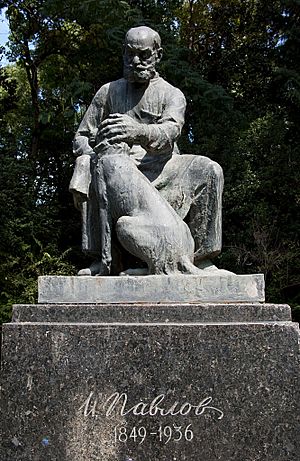Classical conditioning facts for kids

Classical conditioning, also known as Pavlovian conditioning, is a way we learn by connecting things. It's a type of associative learning, which means learning to link two or more ideas or events together.
Ivan Pavlov, a scientist, first showed how this works in 1927 using dogs. He noticed that if two things happen together often, an animal (or even a person) learns that they belong together. One thing is usually "neutral," meaning it doesn't mean much on its own. The other thing already has a meaning or causes a reaction. After a while, just seeing the neutral thing can cause the same reaction. Pavlov called this a conditional reflex, and today we call it a conditioned reflex or response.
Pavlov's famous experiment involved dogs. Each time before he fed the dogs, he would ring a bell. The dogs soon learned that the bell ringing meant food was coming. So, they started to salivate (their mouths watered) when they heard the bell, even before they saw or smelled the food. This showed they had learned to connect the bell with food.
Classical conditioning, along with another type called operant conditioning, became very important in a field of psychology called behaviorism. Behaviorism was a major way of thinking about how people and animals learn in the mid-1900s. It still helps us understand how we learn and how animals behave.
Most studies on conditioning have been done on animals with backbones, like rats and pigeons. But scientists have also studied it in animals without backbones, like the sea slug. These studies have taught us a lot about how our brains learn.
Pavlov believed that conditioning doesn't teach us completely new actions. Instead, it teaches us to react in old ways to new things.
Contents
How Classical Conditioning Helps in Therapy
Classical conditioning ideas are used in some types of therapy to help people. These include aversion therapy, systematic desensitization, and flooding.
Aversion Therapy for Habits
Aversion therapy helps people stop unwanted habits. It does this by linking the habit with something very unpleasant. For example, a person might take a medicine that makes them feel sick if they do a certain unwanted action. This helps them connect the bad feeling with the habit, making them want to stop.
Systematic Desensitization for Fears
Systematic desensitization is a treatment for phobias (strong, irrational fears). In this therapy, a person learns to relax. Then, they are slowly and gently shown things that make them anxious, starting with small fears and moving to bigger ones. The goal is to link the feared thing with relaxation, which is the opposite of anxiety. This process is called counter-conditioning.
Flooding Therapy for Anxiety
Flooding is another way to help with phobias and anxiety. It involves exposing a person to the thing they fear in a safe way, but for a longer time. The idea is that if the feared thing doesn't actually cause harm, the anxiety response will eventually fade away. "Flooding" usually means actually being around the feared thing. "Implosion" means imagining it, but sometimes these words are used to mean the same thing.
Conditioned Hunger and Appetite
Things that regularly happen before you eat can become "conditioned stimuli" for hunger. This means they can make your body get ready for food and digestion. For example, your stomach might start making digestive juices, or certain hormones might be released. These changes can make you feel hungry.
A good example is the "appetizer effect." If you always eat dinner at 6 PM, just seeing the clock show 6 PM can make you feel hungrier than you were before. Your body has learned to connect that time with food.
Classical Conditioning in Stories
Classical conditioning ideas have appeared in many books and movies.
Brave New World and Society
In the 1932 novel Brave New World by Aldous Huxley, conditioning is very important. It helps keep society peaceful and makes sure everyone stays in their assigned social group, or caste. People are conditioned from a young age to like their place in society.
A Clockwork Orange and Behavior
Another example is in Anthony Burgess's 1962 novel A Clockwork Orange. The main character, Alex, goes through a process called the Ludovico technique. During this, he is given a solution that makes him feel very sick. At the same time, he is made to watch certain actions. This makes him unable to do those actions himself without feeling very sick. It's an extreme example of using conditioning to change behavior.
Images for kids
See also
 In Spanish: Condicionamiento clásico para niños
In Spanish: Condicionamiento clásico para niños




